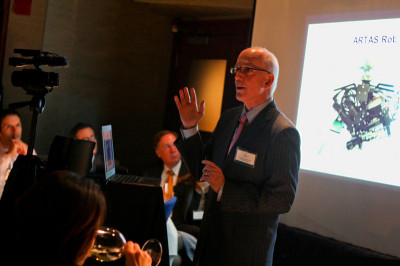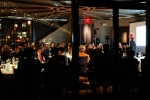Dr. Bernstein was honored to deliver the keynote address at the ARTAS International Users Forum in San Francisco, California. Dr. Bernstein’s presentation, “Follicular Unit Extraction: Then and Now,” was a review of the evolution of surgical hair restoration from Follicular Unit Transplantation (FUT) through Follicular Unit Extraction (FUE) to the cutting edge technique of Robotic-FUE.
The presentation described the steps that resulted in the use, and growth in popularity, of the state-of-the-art ARTAS Robotic System for FUE. Dr. Bernstein pointed out that with the introduction of each procedure — FUT, FUE, and Robotic-FUE — there was initially a rocky reception with physicians. In each instance, however, the surgeons’ concerns were overcome first by strong, patient interest and then by clinical studies that confirmed the procedures’ usefulness.
Dr. Bernstein discussed how FUE procedures progressed from the use of hand-held instruments to the computer-assisted, image-guided ARTAS Robot. One of the initial hurdles of FUE procedures using hand-held devices was a high rate of follicular unit transection (cutting of the follicles). Restoration Robotics, Inc., the company that developed the ARTAS system, used a “sharp/blunt” punch technique that was introduced by Jim Harris in his 2004 publication on the SAFE System for FUE. The sharp/blunt technique, that was validated in 2006 by Dr. Bernstein’s research publication, “New Instrumentation for Three-Step Follicular Unit Extraction,” reduced transection of follicles when compared to older instrumentation. Dr. Bernstein then detailed modifications to the system that he proposed in order to improve the ARTAS robot. These improvements include: a smaller tip for the sharp/blunt punch, selection of larger over smaller follicular units, tensioner placement, ‘feathering’ the ends of the tensioner, and pre-making recipient sites before extracting the follicular unit grafts.
Looking to the future, Dr. Bernstein mapped out the further evolution of the Robotic FUE procedure and the tasks it will be required to perform. In future procedures, the physician will not only guide the robot on extracting follicular units, but also in creating recipient sites and, further down the road, placing grafts into the recipient sites. Graft placement will represent the most significant challenge to the robotic system as this step is the most sensitive to patient to patient variability. Once this last step is accomplished, a fully automated hair transplant should be possible, eliminating much of the human error in the mechanical aspects of the hair restoration process.
More photos from the event:
Posted by









